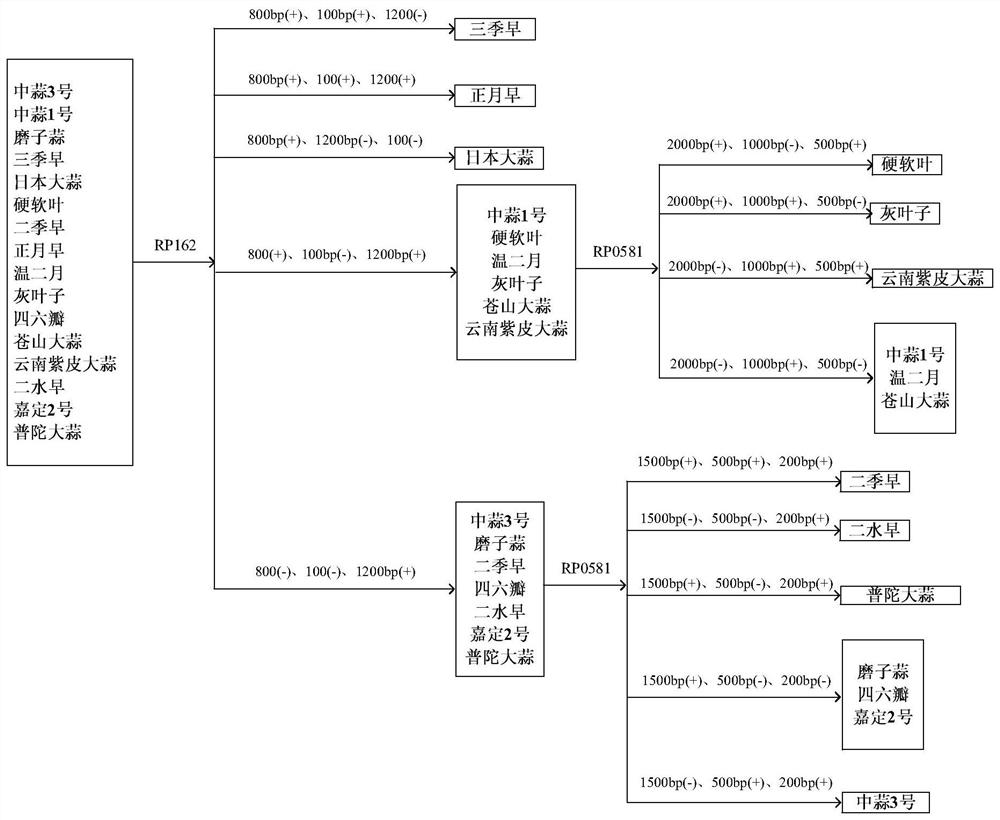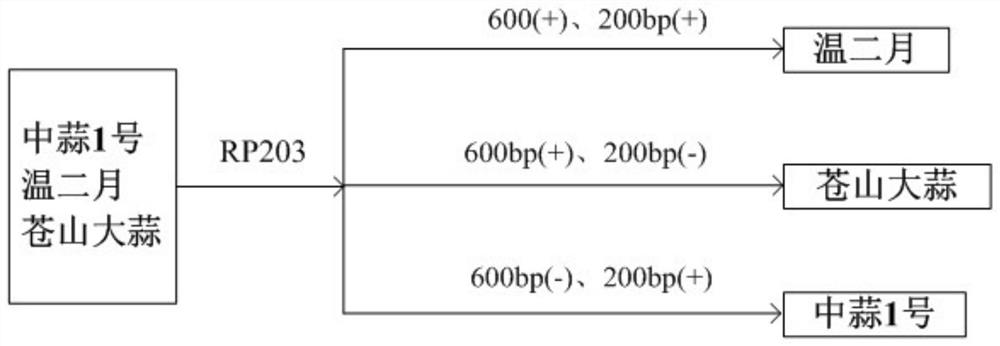RAPD (random amplified polymorphic DNA) primer for distinguishing garlic varieties and application of RAPD primer
A variety and garlic technology, applied in the field of molecular biology, can solve the problems of large operation volume, lack of practicability, and inability to visually display the primers for distinguishing varieties, so as to achieve the effect of simple operation, wide versatility and early identification.
- Summary
- Abstract
- Description
- Claims
- Application Information
AI Technical Summary
Problems solved by technology
Method used
Image
Examples
Embodiment 1
[0041] Example 1: Extraction of DNA.
[0042] The garlic variety samples of the present invention are all common and important garlic varieties in the market, and these 16 varieties include: 'Zhongsuan No. 3', 'Zhongsuan No. 1', 'Mozi Suan', 'Sanjizao', 'Japanese Garlic' , 'Hard and Soft Leaves', 'Second Season Early', 'First Moon Early', 'Wen February', 'Grey Leaf', 'Four or Six Petals', 'Cangshan Garlic', 'Yunnan Purple Garlic', 'Er Shui Zao ', 'Jiading No. 2', 'Putuo Garlic'.
[0043] Take 0.2g of young garlic leaves, grind them with liquid nitrogen, add 500μl of CTAB lysate, transfer to a 1.5ml centrifuge tube, take out and cool in a water bath at 65°C for 0.5-1h, add an equal volume of chloroform / isoamyl alcohol mixture and gently Shake, 12000r / min, centrifuge for 8-10min, extract the supernatant with chloroform / isoamyl alcohol mixture 1-2 times, add pre-cooled isopropanol, let stand at 4°C for more than 3 hours, collect flocculent DNA Wash with ethanol with a volume fr...
Embodiment 2
[0045] Example 2: RAPD-PCR reaction system and conditions.
[0046] RAPD-PCR reaction system is 20μl, containing 50ng genomic DNA, 2.0mmol L -1 MgCl 2 , 0.15 mmol·L - 1 dNTPs, 0.44 μmol L -1 10mer primers, 0.75U Taq DNA polymerase.
[0047] The RAPD-PCR amplification program was pre-denaturation at 94°C for 3min; denaturation at 94°C for 40S, annealing for 50S, extension at 72°C for 90S, 40 cycles; extension at 72°C for 8min, and then stored at 4°C. Amplify on the PCR amplification instrument, the amplified product adopts agarose gel electrophoresis (containing 1.2% ethidium bromide), 1 × TAE electrophoresis buffer (contains in 1L: 0.242g Tris, 0.057ml glacial acetic acid, 0.2 ml 0.25mol / L EDTA pH 8.0). Add 4 μl of 6× loading buffer (containing 0.25% bromophenol blue, 30% sucrose) to the amplified DNA sample, and perform electrophoresis at a constant voltage of 120V for 0.5-0.8 hours until the amplified DNA bands are clearly separated After that, the amplified bands we...
Embodiment 3
[0048] Example 3: Stringent screening of specific primers.
[0049] The three primers of the present invention are obtained through strict screening of 38 random primers originally designed. First, 38 random primers were designed for the genome of the existing garlic varieties, and 13 bases of RAPD random primers with good polymorphism, strong amplification and high stability were selected, and then the strips were selected through two consecutive gradient PCRs. Take a consistent temperature as the annealing temperature. In detail, the gradient PCR reaction system is 20 μl, containing 50ng genomic DNA, 2.0mmol·L -1 MgCl 2 , 0.15mmol·L - 1 dNTPs, 0.44 μmol L -1 10mer primers, 0.75U Taq DNA polymerase. The reaction was pre-denatured at 94°C for 3min; denatured at 94°C for 40S, annealed for 50S, and extended at 72°C for 90S, 40 cycles; extended at 72°C for 8min, and then stored at 4°C. The random primer sequence and annealing temperature of the present invention are as fo...
PUM
 Login to View More
Login to View More Abstract
Description
Claims
Application Information
 Login to View More
Login to View More - R&D
- Intellectual Property
- Life Sciences
- Materials
- Tech Scout
- Unparalleled Data Quality
- Higher Quality Content
- 60% Fewer Hallucinations
Browse by: Latest US Patents, China's latest patents, Technical Efficacy Thesaurus, Application Domain, Technology Topic, Popular Technical Reports.
© 2025 PatSnap. All rights reserved.Legal|Privacy policy|Modern Slavery Act Transparency Statement|Sitemap|About US| Contact US: help@patsnap.com



